Menu
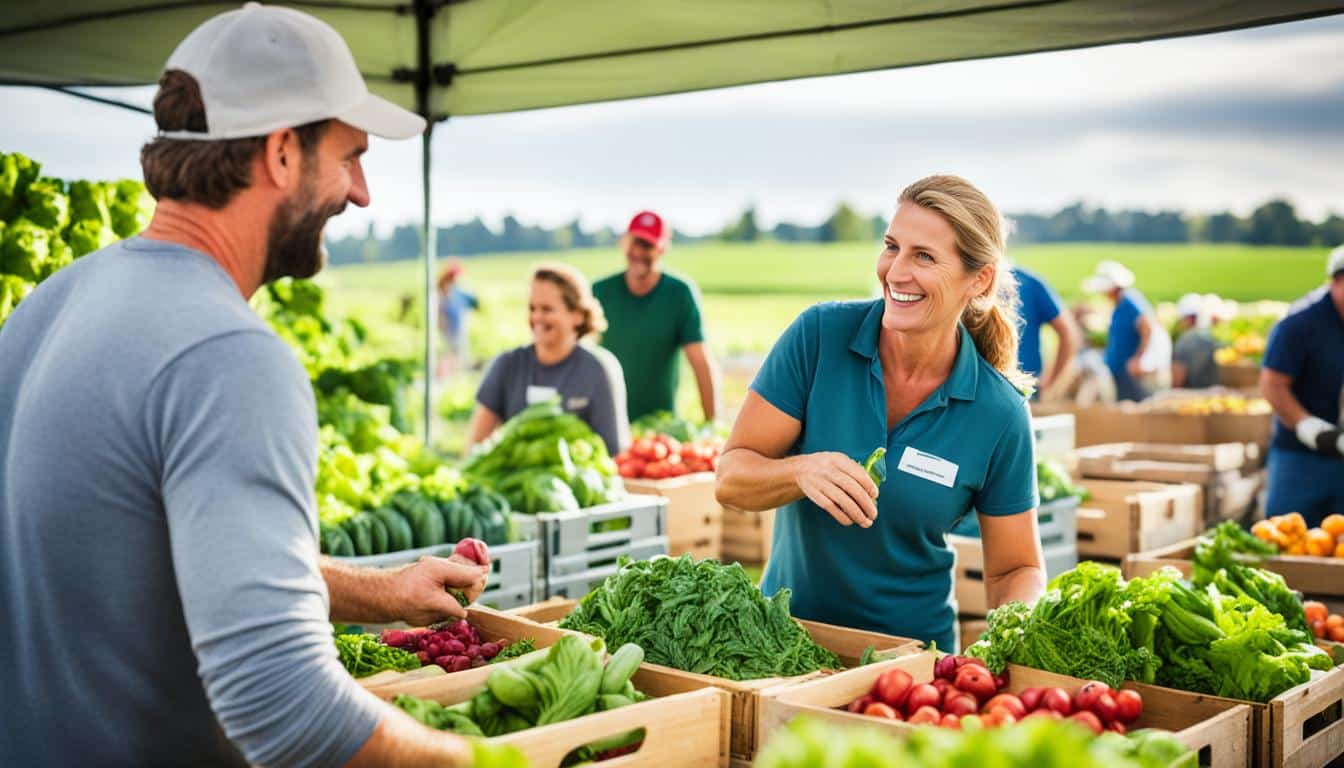
Did you know that joining a Community-Supported Agriculture (CSA) farm could cost you between $400 and $700 a year? There are over 2,500 CSAs in the United States and more than 100 in North Carolina. This model is really helping local food get to our tables.
Community-Supported Agriculture (CSA) is a different way to think about where our food comes from. It connects local farmers directly with people who want to eat their produce. By signing up, you help farmers cover their costs at the beginning of the season. In return, you get a share of whatever they grow. This helps farmers with money and creates a community focused on eating well.
Community-Supported Agriculture (CSA) is all about linking people with the farms that grow their food in a sustainable way. The number of farms joining this initiative in the US has grown a lot. By 2012, it had reached 12,617, showing a twelve-fold increase since 2006. This growth highlights how local food movements are becoming more popular and how they help local economies.
In a CSA, consumers pay farmers in advance for seasonal fruit and veg. This way, they join in on the farm’s journey for that year. Since nature’s not always predictable, sometimes there might be more or less produce. In places like New England, CSAs last six to seven months, using special methods. But in California, they can offer organic produce all year.
CSAs work in a really interesting way. At the start of the season, people buy shares that help cover the farm’s early expenses. These could be things like seeds, soil enhancers, and tools. In exchange, they get fresh, healthy food that’s usually grown without any harmful chemicals. The price is not fixed and can range from $20-$50 a week, adding up to $400-$800 for the whole season.
People who join a CSA often end up eating more vegetables. This boosts their health and happiness. Scientific research by Hanson et al. (2017) supports these claims. Plus, CSAs do a lot of good for the environment and for their local communities. They help farmers make a good living, bring people in a community closer together, and take care of the land in a responsible way.
CSAs have their start in the US in 1986. Farms like Indian Line Farm and Temple Wilton Community Farm showed the way. They were inspired by ideas such as Dr. Booker T. Whatley’s “Clientele Membership Club.” This model makes the link between farmers and consumers direct and strong, unlike the usual market setup.
| CSA Aspect | Details |
|---|---|
| Farm Numbers | 12,617 farms as of 2012; more than twelve-fold increase since 2006 |
| Typical Costs | $20-$50 per week per seasonal share; total $400-$800 per season |
| Season Duration | New England: 6-7 months; California: Year-round |
| Payment Model | Prepayment by shareholders to cover seasonal farm costs |
| Health Benefits | Increased vegetable consumption, as shown by various studies |
| Standards | Often adhere to “naturally grown” or “organic” standards |
CSA is much more than just a way to farm—it’s a movement. It’s about using the land wisely to grow food, uniting communities, and choosing a lifestyle that’s good for everyone.
Community-Supported Agriculture (CSA) is key for sustainable food. It connects farmers and consumers closely. Customers buy shares of the seasonal produce.
This way, farmers know their income is stable. And, it encourages taking care of the land. This is good for everyone.
CSA builds a strong bond between farmers and their community. People buy a share of the farm’s produce. This helps cover the farm’s costs.
Today, the U.S. has over 2,500 CSAs. In just North Carolina, there are more than 100. And they grow every year.
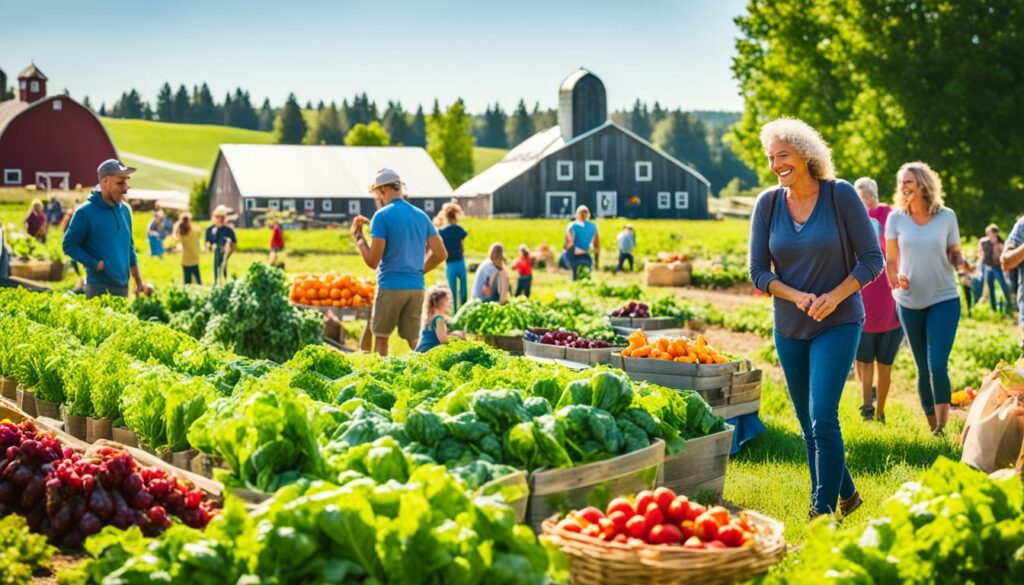
CSAs usually offer full and half shares. A full share can cost between $400 and $700 a year. These prices support the environment and keep farming balanced.
There are ways to pay that fit many budgets. These include paying in parts or working on the farm. This makes joining a CSA easier for anyone who wants to.
CSAs bring many good things. They cut out middlemen, which helps farmers earn more. This way, they give fresh, organic food to people at fair prices.
They use fewer chemicals, making food healthier. Many CSAs also help low-income families by lowering their cost. This makes sure everyone has enough good food to eat.
But it’s not just about money. CSAs get the community together. They do work, have fun, and learn at the farm. This makes people care more about where their food comes from.
In the end, CSAs are vital for keeping farming sustainable. They support the economy, the planet, and welcome everyone. They are a strong part of local food movements.
The US’s Community Supported Agriculture (CSA) has ties to food cooperative networks and local movements. Though the start of CSA is often debated, we know it has changed how local communities view their food.
In 1986, CSAs blossomed with places like Indian Line Farm and Temple-Wilton Community Farm. These farms set the foundation for local food efforts, inspiring many. For example, Indian Line Farm worked with local groups to keep community farming alive in 1999.
Robyn Van En started CSA North America (CSANA) in 1992 to help the CSA model grow. Thanks to her work, CSAs are now nearly 1,700 strong across North America. This means many families get fresh produce from local farms.
Early CSAs like Temple-Wilton had unique ways of working. Their pledge system lets everyone join, no matter their budget. This kind of approach is what makes CSAs stand out, bringing people from all walks of life together.
CSA’s history shows its lasting impact by helping local economies and our planet. Today, it continues to grow, joining more people through community-farming and local food efforts. I’m excited to see how it will progress and enrich us all.
| CSA Milestones | Details |
|---|---|
| 1986 | First CSAs in the US: Indian Line Farm and Temple-Wilton Community Farm. |
| 1992 | CSANA founded by Robyn Van En to support CSA development. |
| 1999 | Indian Line Farm’s partnership with The Nature Conservancy and Community Land Trust. |
Community-Supported Agriculture (CSA) offers a new way to look at farming. It combines ecological, economic, and social benefits. These farms help the environment and local communities by using sustainable farming practices.
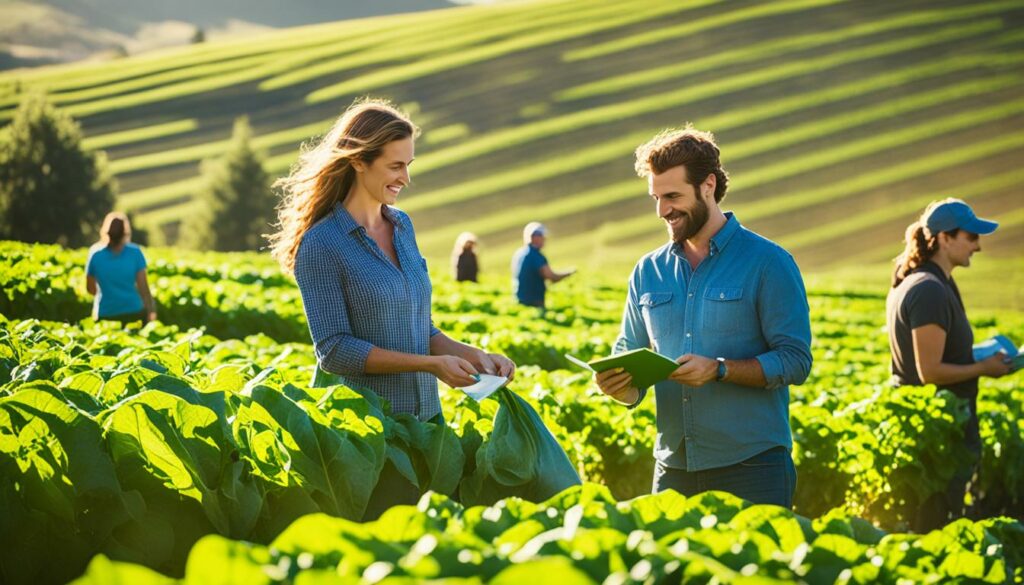
CSAs are all about taking care of the Earth. They use organic farming and grow a mix of crops. This way, they keep the soil and the environment healthy. They play a big part in making sure our planet stays in good shape.
CSAs are good for farmers because they offer a steady income. Members pay in advance for their produce, which helps farmers plan better. This means farmers can buy top-quality seeds and tools, making their farms more productive.
Joining a CSA costs between $400 and $700 a year. This depends on the size of the farm and how long their growing season is. Most CSAs make it easy for members, with just the occasional visit needed, which helps everyone.
CSAs are not just about money; they’re about building a community. They teach people about local food and how to get involved. This creates a bond between people and where their food comes from.
In the U.S., there are over 2,500 CSAs, with more than 100 just in North Carolina. This shows how much they’re valued for including everyone, being good for the economy, and taking care of nature.
CSAs show us a better way to do agriculture, bringing farmers and eaters together. They all work towards a future with healthy food grown right in our communities.
There are many different CSA models. They all aim to support the community’s needs and the farms. The classic form is a single-farm operation. Each farm runs its own CSA, connecting with local people directly. But, there are now more types of CSAs, which have spread the benefits further.
Multi-farm collaborations are an example. Several farms work together, offering a wider range of produce. This attracts more people because of the variety available. It also spreads the risks, showing the beauty of shared harvests.
Workplace CSAs are a new idea. Companies help deliver farm shares to their staff. This not only supports local farmers but also encourages healthy eating at work. Sliding Scale CSAs make it fair for all by changing fees depending on income. So, everyone can join and enjoy the benefits.
Community agriculture affects more than just the food supply. For example, community gardens help families save around $475 on food each year. They also create new jobs. Today, almost a fifth of our food comes from city farms, showing their worldwide value.
But that’s not all. These projects bring economic and environmental good deeds. They cost less than regular parks to build and maintain. They also boost property prices, local jobs, and the income of those involved. Plus, they clean the air, help with flooding, support wildlife, and add more green areas to cities.
| Model Type | Key Features | Benefits |
|---|---|---|
| Single-Farm CSAs | Direct connection between one farm and members | Fosters community bonds, ensures fresh produce |
| Multi-Farm Collaborations | Combines resources from multiple farms | Diverse produce offerings, risk mitigation |
| Workplace CSAs | Deliveries made to employee workplaces | Promotes health, convenience for participants |
| Sliding Scale CSAs | Income-based membership fees | Increases accessibility, inclusivity |
In California, regional help stands out. It supports CSA farms with advice, lobbying, and studies. Nationally, the National CSA Community of Practice pulls together different projects. Globally, Urgenci does the same, helping the food sovereignty cause.
Starting a Community-Supported Agriculture (CSA) is not easy. It needs a lot of planning and a good financial strategy. If you want this to work, you must plan your business in agriculture well and figure out your finances. This way, farmers and members both gain something, making this setup more and more common in the USA.

Good business planning is the first step towards a thriving CSA. Farmers have to think through several important points. They should know exactly what their farm needs and how to communicate with members. They must also figure out how to get their produce to the people. Places like ATTRA and Farm Commons can give great advice on this, getting farmers ready for what’s ahead.
In 2012, the USDA found that more farms were selling via CSA, hitting 12,617. This rise shows a real interest in the community-agriculture approach. Good planning is crucial to get into this growing market. It helps manage costs and creates a strong, flexible farm business.
The financial plan of a CSA is key to keeping it going. Members pay about one hundred pounds a month for produce. This routine payment helps farmers keep a balanced budget all year. A study by Hanson and others in 2017 linked CSA with eating more veggies. This not only boosts member health but also ensures the farm’s financial health.
CSAs also help small farms stay green. They encourage farming in ways that protect the environment, like using different crops to fight pests. For setting fair CSA prices, you can check what Iowa State University suggests. Such a financial strategy makes the farm more stable. It also makes sure members get good value for money and high-quality produce.
| Resources | Description |
|---|---|
| ATTRA and Farm Commons | Guidance on legal and business planning for CSAs. |
| University of Tennessee | Marketing through CSAs, substitutions handling, packaging shares, and pricing shares. |
| Iowa State University | Details on pricing determination for CSA share boxes. |
| University of Wyoming | Comprehensive resource on managing a CSA operation. |
CSA models link farmers and the people in the local area. In the US, there are over 2,500 CSAs, with more than 100 in North Carolina. These models let farmers closely match their goods to what the community wants.
Farmers and consumers both gain from most CSA models. Consumers pay ahead for organic produce subscriptions, making it easier for farmers to plan and know their income. Even though some CSAs lose a percentage of members each year, those that get their members involved in the farm tend to keep them longer. It means more help for the farm and teaches about sustainable ways to farm.
Many CSA models aim to be open to everyone. They offer different ways to pay or adjust the price based on someone’s income. In some places, people can use programs like WIC and SNAP to join a CSA. There is also the chance to share work for a share in the farm’s produce.
Often, people’s first CSA hearing is from someone they know. Then, things like visiting the farm or listening to a talk can help spark interest. Teaching members how to use fresh food is key. It helps build a strong and involved community around the farm.
| Aspect | Details |
|---|---|
| Annual Cost | $400 – $700 |
| Total CSAs in the U.S. | 2,500+ |
| CSAs in North Carolina | 100+ |
| Member Turnover Rate | 25-70% annually |
| Cost-Effectiveness | Up to 2.5 times cheaper than local stores |
| Payment Plans | Available in many CSAs |
| SNAP/WIC Benefits | Accepted in some states |
| Work-Share Memberships | Available in some CSAs |
Studies from West Virginia show that joining a CSA can save money. It’s often cheaper than buying fresh produce from stores. This, plus the ways CSAs can work with people, makes them an important part of farming sustainably.
Community-Supported Agriculture (CSA) has changed over the years, with new ideas making farm-sharing more open to everyone. Now, there are more ways to join in that meet different people’s needs. These changes mean more folks can get involved, making the farm family bigger.

Multi-Farm CSAs join many farmers together. This makes a wider range of fresh foods available for members. By working as a team, they can provide a steady supply of food. They also found a way to balance costs better, which keeps more people sticking around.
At workplaces, CSA delivers farm-fresh food to staff’s doorstep, greening office life. It helps people eat better and feel better. With memberships costing between $400 and $700, some businesses help cover this cost. This means more employees can take part, leading to a healthier work environment for all.
Sliding scale CSAs are a forward-thinking option, offering farming shares at different prices. This way, more people can join regardless of their budget. By doing this, they build a more inclusive and healthier community. Some even give shares to those who need it most, like low-income families, showing their dedication to community care.
In the United States, there are now over 2,500 CSAs, with North Carolina hosting over 100 alone. These adaptable models are shaping the future of local foods, with community efforts at the core. From picking crops to sharing them out, CSA members are keeping the movement alive and growing.
Community-Supported Agriculture (CSA) initiatives face many challenges. These affect their growth and success in sustainable farming. A big issue is handling both crop production and keeping a solid consumer base. Studies show that getting people to join CSAs is tough. This lack of involvement slows down community growth.
Consumers struggle to connect deeply with CSAs. Building emotional and social bonds is key for CSAs to work well. But, this part is often not strong enough, making it hard for consumers to share their problems. This can lead to client loss and dissatisfaction.
When partners don’t fully engage in the work, it is a challenge. If farmers take on too much, small farms can suffer. Plus, the nature of small-scale production makes expansion difficult. This is because it’s harder to meet the growing needs of consumers.
Changing to new farming methods is not always welcomed. Sometimes, when people try new ideas, they face a lot of disagreement. This highlights the need for constant change in farming. The difference in approaches can make it tough for CSAs to grow.
Getting consumers to become more involved changes how they see food and farming. But, this change comes with risks. It can cost a lot to start, and getting new people on board is always needed. Despite over 12,500 farmers trying CSAs in 2007, ten percent close each year. This shows how tough the business can be.
Money problems are a big issue for CSAs. In 1999, the average annual income was $15,000. For those that relied on CSAs, the total income was between $20,000 and $30,000. Yet, a CSA in Europe serves over 45,000 families. This shows the wide range of success within the CSA movement.
| Challenges | Details |
|---|---|
| Consumer Engagement | Low participation and difficulty in establishing community ties |
| Responsibility Overload | Risk of farmer overload due to numerous responsibilities |
| Resistance to Change | Opposition to alternative farming models |
| Financial Viability | Low average annual income and high business closure rate |
So, CSAs must keep adapting to survive. This means changing the way they work to overcome the challenges they face.
Community-Supported Agriculture (CSA) opens doors for strong farming communities. A major chance for growth is using tech to improve how CSAs work. This includes making it easier to join, handle payments, and manage the sharing of crops, all online.
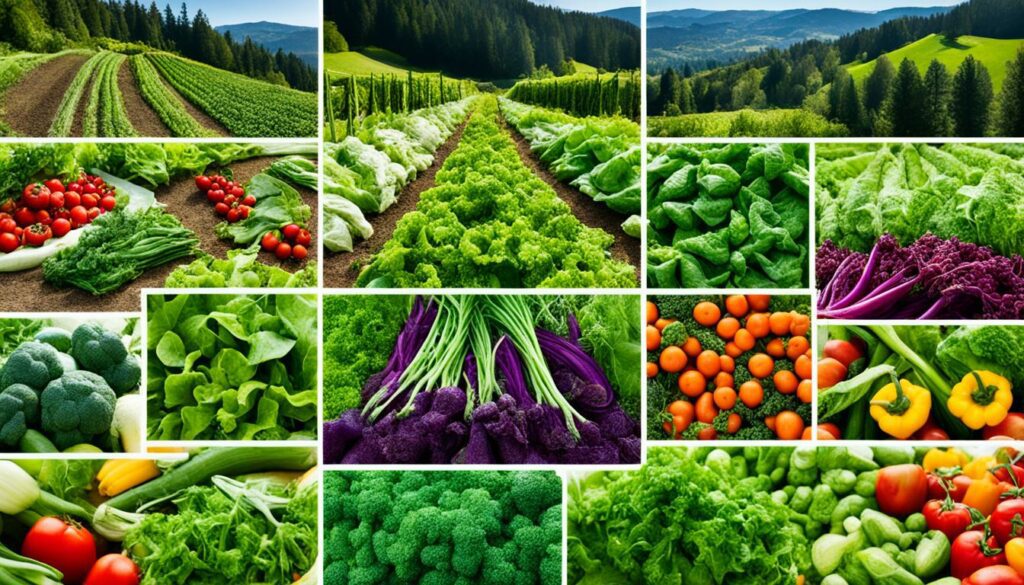
People care more about their health and the planet than ever. This has created a big market for CSA farm shares. CSAs, through these changes, are finding more members. They are also gaining solid support from their areas.
CSAs can do a few things to get ahead. They can let members work in exchange for their shares. This keeps people involved and lowers the number of members who leave. CSAs can also offer reduced fees for those who can’t afford the full price, making it fair for all.
In the U.S., there are more than 2,500 successful CSAs, with North Carolina leading with over 100. This tells us there’s room for more and that CSAs can be made in many different ways. This includes who owns the land, with options like renting or using land trusts.
The next part shows what to think about when setting up costs and inviting people to join.
| Factor | Details |
|---|---|
| Annual Cost | $400 – $700 depending on factors like harvest season length and product variety |
| Member Retention | 25-70% of members may leave each season; higher retention with active member participation |
| Share Pricing Methods | Market price, market value approximation, cost calculation, community farm model |
| Member Engagement | Including work-share memberships and flexible payment plans |
CSAs have big potential, thanks to new tech and changing food interests. They can help build strong, lasting local food scenes. This way, CSAs are at the forefront of creating a future with sustainable and fair food for everyone.
Success in Community-Supported Agriculture (CSA) shows how farmers and consumers work together. Global CSA projects prove this model helps create sustainable farming. Let’s see some amazing examples and what we can learn from them.
Since 1965, Japan’s Teikei system started the trend of farmers and consumers supporting each other. It has influenced CSA projects worldwide. Germany’s LBF, from 1968, and Switzerland’s Les Jardins de Cocagne, from 1978, are great examples. They show how working with the community can support farming. This leads to stronger local connections and care for the environment.
In the US, places like Indian Line CSA and Temple-Wilton Community Farm, both from 1986, are key. They helped create over 13,000 CSAs in the USA by 2012. Projects like Spring Hill Community Farm in Wisconsin have kept members happy over the years. This is thanks to their consistent quality and building trust. Equinox Community Farm, near Waunakee, shows that with hard work, a CSA can grow strong with 200 to 250 members.
Successful CSAs have a few things in common. Being able to change is very important. Vitruvian Farms in Wisconsin switched their sales to include a CSA. This helped them make more money. It also shows the importance of links with the community and care for the environment. The successes of the Teikei system in Japan and the FairShare coalition in Wisconsin prove this.
Finally, good CSAs help the planet, make food better, and bring people together. They do this by offering different ways to join. This makes more people want to be a part of their community. By doing this, they create places where farming is strong and everyone is welcome.
Lately, lots of agricultural technology has changed the game for CSA farming. This new tech makes managing subscriptions much easier. It also helps in talking to customers better, through easier ways of communication.
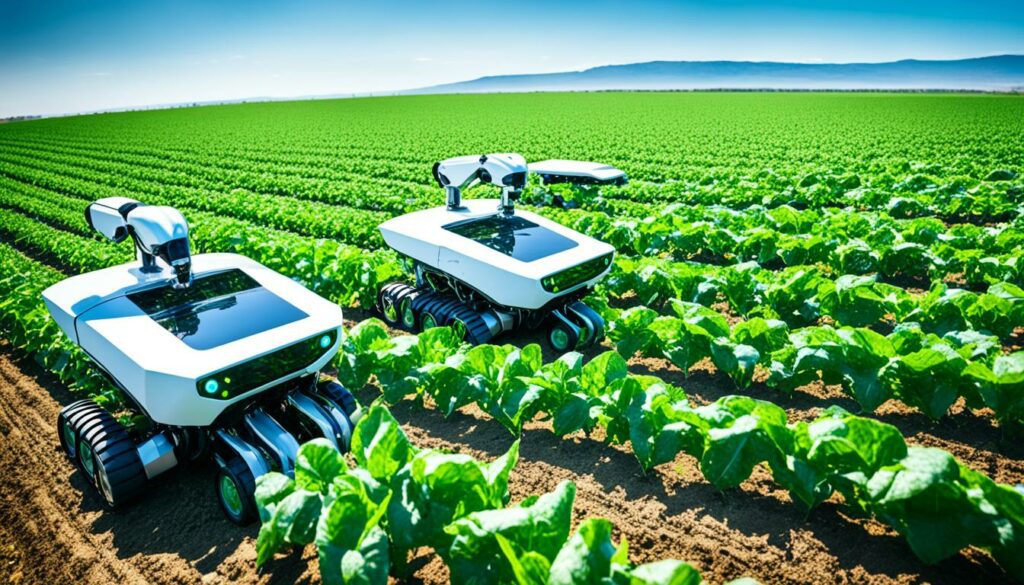
Now, CSA farms use online tools for subscriptions. This saves time on paperwork, letting farmers focus more on their crops. Also, with the help of mobile apps, customers can track their produce. They can even give feedback easily, making the farming community more united.
There are also cool tools that keep an eye on the soil and crops all the time. These gadgets help farmers make smart choices, cutting down on costs and improving what they grow. For example, using drones helps spot pests early and apply nutrients where they’re needed most. This makes managing the crops better and saves time.
The USDA notes a big increase in CSA farms, jumping from 728 to 12,617 between 2006 and 2012. This rise is thanks to the user-friendly and clear features of modern agricultural technology. It’s making CSA more appealing for both farmers and those who buy their produce.
Important people have been key in developing the Community-Supported Agriculture (CSA) movement. They share values that go beyond just farming. Thanks to their work and encouragement, we have a strong focus on sustainable farming today.
Jan Vander Tuin is a big name in the CSA world. He helped start the first CSA in the U.S., Indian Line Farm, with Robyn Van En in 1986. Thanks to him, many people are now champions of sustainable farming.
Vander Tuin showed how CSA models could work well. He helped farmers get the money they needed upfront by selling shares. This method supports smaller farms. He also pushed for methods that protect our planet and promote a wider variety of life.
Dr. Booker T. Whatley is another standout. He’s known for his ten rules for good farming, which he shared back in the 1960s and 1970s. Whatley’s teachings focus on community and looking after the environment. These values are crucial in the CSA world.
Now, technology is making CSAs even better. It helps farmers manage their subscriptions and talk to their customers easily. With both new technology and wisdom from the past, CSAs are becoming even more vital. They help lower greenhouse gases and bring people together.
The work of these sustainable farming heroes lives on today. They’ve really shaped the CSA movement. Now, choosing local CSAs is a big win for everyone. It strengthens our food system and supports a better, more fair future.
Community-Supported Agriculture (CSA) is changing because people want local, organic food. The future of CSAs looks bright with more people choosing this way of getting food. This shows a strong future for such a farming method.
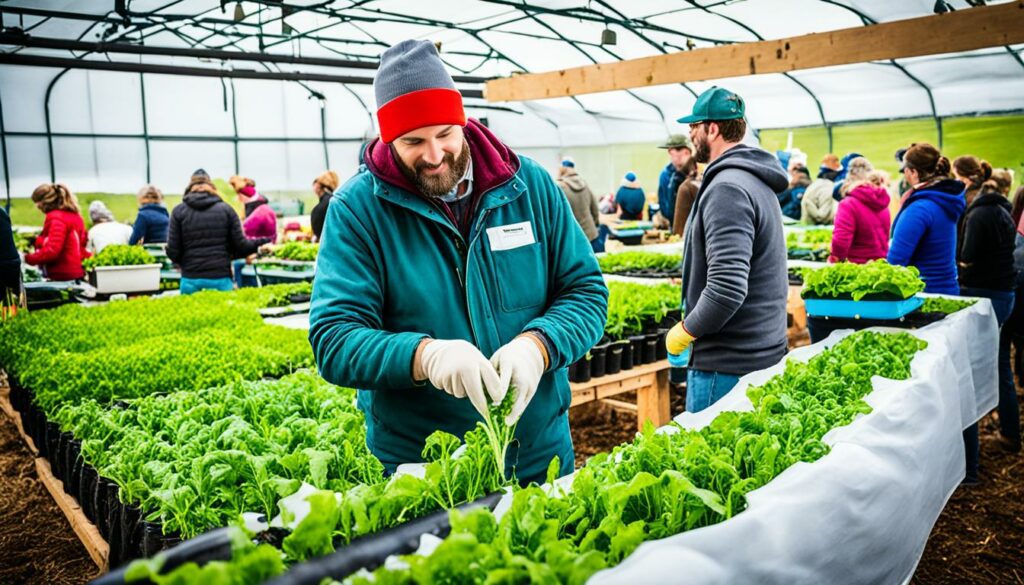
People now love to support local farmers and eco-friendly farming. They want fresh, organic food with clear origins. From 2012, there’s been a big jump in CSAs in the US. This means more people are choosing to invest in local food. They often pay around $100 a month to support quality farming directly.
There are exciting changes in community agriculture. New CSA setups are meeting more community needs using tech. They include working with many farms, flexible payments, and tailor-made food boxes. This makes fresh food more available and affordable. For example, in New England, they use tech to grow food for longer. And in California, they farm all year. These new ways not only meet what people want but also bring farms and communities closer.
Tech is also making CSAs better. Better ways to talk, online services, and apps are being used. These help farmers and buyers connect better, improve the buying experience, and sort out deliveries. With tech, CSAs can change quickly, keeping up with what consumers want and staying important in farming.
Being part of a Community-Supported Agriculture (CSA) programme has big advantages for your health and how well you fit into your community. You get top-notch, fresh food that was picked just before you got it. This means you’re eating meals that are high in nutrients. Plus, it’s a great way to eat more fruits and vegetables, making your diet much better.
Joining a CSA can also save you loads of money. Studies show you could pocket up to $500 each year by not shopping for organic goodies at stores. What’s more, CSAs let farmers have more of the share, skipping the bit that often goes to middlemen.
The part CSAs play in your community is also really special. You get to know the farmers who grow your food. This helps you learn more about how it’s all done and builds trust. A perfect example is Minnesota, filled with local farms and lots of spots to pick up your food.
Choosing a CSA means you’re picking a greener way to eat. Local food doesn’t have to travel far, which cuts down on gas use and pollution. This shift is a key part of fighting the issues hidden in the big money world of pesticides and fertilisers. It supports the planet and is better for everyone’s health.
Many CSAs now offer easy ways to pay, like spreading the cost over the season. This makes them more open to different people and easier to manage financially. Also, the way CSAs use subscriptions is really handy. It ensures they meet the needs of the present-day customer.
CSAs also introduce you to a wide range of foods. Think about all the special and different types they grow. This mix makes your meals more interesting, which is good for you. And you’re helping the farmers work without relying on loans. This lets them buy what they need and sells goods without much stress.
And finally, CSAs often treat their animals in a way that respects them. This is a big draw for people who care about where their meat comes from. It also deepens your connection to farming and nature, which can make you feel really good.
Community-supported agriculture (CSA) is a full system linking ethical farming with community health. It connects farmers directly with those who eat their produce. This method is great for making sure our local food is both fresh and good for us.
CSAs have changed over time to fit modern needs. At first, people would buy a CSA share for the whole season, paying at the start. This gave farmers the money they needed early on. Nowadays, CSAs offer more choice in what you get, when you get it, and how much you buy. These changes make CSAs more practical and keep local farming strong.
The Michigan State University Extension helps people learn about CSAs and other ways to get local food. There are many benefits to joining a CSA. You get fresh food that keeps its nutrition, you find new types of produce, and you become part of a community of local food lovers.
In Europe, CSAs help many families eat well and keep the countryside alive. They do this by supporting local farmers and offering healthy food. The impact of CSAs on our food and communities is big. They make sure farmers can do their job and we can enjoy fresh, nutritious food. By backing CSAs, we help create a better food system for everyone.
A CSA is a way for people to support local farms directly. Members pay at the start of the season for a share in the farm’s produce. This helps farmers with money early on and gives members fresh food later.
CSA initiatives help the environment by encouraging organic farming and protecting wildlife. They also reduce the need for harmful chemicals. This way of farming keeps the soil healthy and helps local farmers stay in business.
Joining a farm share program means you get to enjoy fresh crops from local farms. It supports farms that care for the planet and you know where your food comes from. Plus, it strengthens your connection with the community.
CSAs started in Europe and Japan before coming to the US in 1986. Early influencers like Dr. Booker T. Whatley had ideas similar to today’s CSA. They wanted to help small farms survive and grow.
CSAs matter because they focus on sustainable farming that helps the Earth, farmers, and communities. They support organic practices and bring people together over good food. This makes them essential in today’s farming world.
There are many types of CSAs, from those run by one farm to groups working together. Some cater to workplaces while others vary their prices based on income. This variety meets a range of community and farm needs.
When starting a CSA, lots of planning and understanding are needed. Think about costs, how members will join, and legal stuff. Good planning makes sure your CSA runs smoothly and stays financially healthy.
Technology helps CSAs in many ways, from managing subscriptions to keeping in touch with customers. It makes sharing info about food and pickups easy and helps attract new members. Technology also boosts marketing for CSAs.
Successful CSAs are all over the world, like in California and Poland. They show that CSAs can adapt and help both the planet and people. These CSAs are known for their quality food and environmental benefits.
CSAs help more people eat well by offering memberships at different prices. This makes fresh, local food more available to everyone. It not only helps with health but also builds trust in local food supplies.
Key figures in the CSA movement include Jan Vander Tuin and others who have championed its values. Their work has helped shape current CSAs and highlights the role of CSAs in making food systems sustainable.
In the future, CSAs will likely see more demand for local, organic food. New models will use technology and offer flexible pay options to meet people’s needs. This shows how CSAs are evolving to stay relevant.
Joining a CSA can save you money on fresh, organic food and increase your veggie intake. You also feel more connected to where your food comes from. In some areas, low-income households can get help to afford CSA shares.